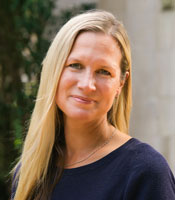
Gretel Van Wieren is Professor of Religious Studies and affiliated faculty in Philosophy at Michigan State University where her research and teaching explore the spiritual and moral dimensions of people’s relationships to land. She is the author of the books, Listening at Lookout Creek: Nature in Spiritual Practice (Oregon State University Press, 2019), Food, Farming and Religion: Emerging Ethical Perspectives (Routledge, 2018) and Restored to Earth: Christianity, Environmental Ethics, and Ecological Restoration (Georgetown University Press, 2013). Van Wieren is founder of The New Ethics of Food Network and founding member of The Restoration Ecology Global Education Network and The Blue River Quorum. She is recipient of a 2015 H.J. Andrews Experimental Forest Writing Residency, a 2016 Mellon Foundation Humanities Without Walls Grant and a 2017 University Teacher-Scholar Award. Van Wieren received her Ph.D. in Religious Studies from Yale University.
Gretel's residency project, Sacred Swamps, is a basis for a larger book project on the sacred qualities of swamps, bogs and marshes. She writes:
Wetland ecosystems are increasingly recognized by scientists and the general public for their critical role in promoting water and air quality, soil health, biodiversity, wildlife habitat, and climate mitigation. Yet their spiritual, aesthetic, and moral significance has been overlooked. This is too bad, I would argue, for swamps have played an important role in the American environmental imagination, as well as in some spiritual traditions. Thoreau, for example, called the swamp, sanctum sanctorum, a sacred place; Carson viewed her salt marsh “as nearly eternal as any earthly life can be.”
Swamps too have played an important role in my own sense of connection to the natural world. My deepest experiences of nature have been in my home place -- the northwest lower peninsula of Michigan where the Little Manistee River runs through the Manistee National Forest. This is where I came to love the water and woods, and where I am now trying to teach my three children to do the same. I want them to know the forest as a sacred place -- and as a livable place. For me and my family, that means learning how to fish, hunt and, forage. To learn these practical arts requires knowing a place, its make-up and contours, paths and parts, including the swamps that run along the river and dot the woodlands. This means learning how to stand in and wade through muck, moss, grasses, and brush, and how to survive the mosquitoes; it also means learning how, along the way, to appreciate spring’s first skunk cabbage and jack-in-the-pulpit. The Cedar Creek residency serves as a basis for a larger book project (Sacred Swamps) I am developing on the sacred quality of swamps and their close cousins bogs and marshes. A project in “re-story-ation,” to use Robin Wall Kimmerer’s term, Sacred Swamps works to a) uncover and reveal narratives about swamps that have been underrepresented in dominant cultural accounts, and b) develop some new narratives about swamps based on my immersion in the wetlands of Cedar Creek.
A central aim of the project is to “chart” a variety of ways of knowing about and valuing swamps -- scientific to intuitive, empirical to affective. Integral to this will be spending a significant amount of time “sink[ing] kneedeep in bog mosses” (to quote Cedar Bog’s conservator, Cora Corniea, as told by Grace Lee Nute in her 1961 tribute to Corniea in the Naturalist). It will also involve engaging with Minnesota tribal leaders and historians to learn how Ojibwe and Dakota worldviews and practices involve wetland areas. Having such a richly storied and diverse array of wetlands to work with narratively will be particularly generative for the writing process, as will the physical and mental space to be submersed in swamp-scape.